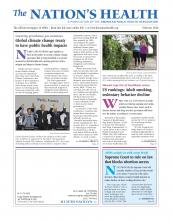While the U.S. has made progress in reducing mortality from heart attacks and strokes, cardiovascular disease continues to be the nation’s top cause of death, according to new statistics released in December.
Compiled by the American Heart Association, in partnership with agencies such as the Centers for Disease Control and Prevention and National Institutes of Health, the “2016 Heart Disease and Stroke Statistics Update” found that in the U.S. in 2013, nearly 801,000 people died from heart disease, stroke and other cardiovascular diseases, which translates into one out of every three U.S. deaths.
Heart disease, in particular, continued to be the leading cause of death in the U.S., killing more than 370,000 Americans every year, even though the death rate from heart disease has fallen by about 38 percent between 2003 and 2013. Findings from the 2016 statistics update were published in December in the journal Circulation.
“We have been making progress,” Mark Creager, MD, American Heart Association president, told The Nation’s Health. “But we have a long way to go — the battle is not won.”
The statistics update reported that about 2,200 Americans die each day from heart attack, stroke and other cardiovascular diseases, or about one person every 40 seconds. Nearly half of black adults — 48 percent of women and 46 percent of men — are living with some form of cardiovascular disease. In addition, heart disease, in particular, is the top killer of U.S. women.
When it comes to stroke, the medical emergency happens about once every 40 seconds in the U.S. and ends in death about once every four minutes. Stroke is the No. 5 leading cause of death in the U.S., killing nearly 129,000 people a year, and is the leading preventable cause of disability. Overall, cardiovascular diseases cause more death than all forms of cancer combined.
On a global scale, the statistics update reported that cardiovascular disease is the leading cause of death worldwide, resulting in more than 17.3 million deaths every year. And that number is expected to increase to more than 23.6 million deaths by 2030. In addition, as of 2010, global prevalence of stroke was 33 million, with stroke ranking as the No. 2 cause of death worldwide.
The update also compiled statistics on health factors and behaviors that contribute to heart health and disease, such as smoking, physical activity, diet, obesity, high blood pressure and cholesterol. For example, the update reported that as of 2014, about one in three U.S. adults reported no physical activity outside of work, and between 2009-2012, about 33 percent of U.S. adults had high blood pressure.
According to Creager, who also serves as the director of the Dartmouth-Hitchcock Heart and Vascular Center, lifestyle and behavior improvements, such as declines in smoking, have contributed greatly to reduced heart disease- and stroke-related deaths, as have medical innovations in heart attack response and care. However, he said that the nation must “redouble” its efforts on a number of fronts to continue making inroads and sustain current progress.
“This is a societal problem and we need to turn to communities, states and even the federal government to help institute changes that will benefit society as a whole,” Creager told The Nation’s Health. “We need to build a culture of health.”
For example, he noted that decision-makers across private and public sectors have a role in instituting smoke-free environments, making sure residents have access to nutritious foods and creating safe spaces where adults and children can be physically active. Creager added that investing in prevention efforts will also save money in the long run. The 2016 statistics update reported that from 2011 to 2012, the direct and indirect costs of cardiovascular diseases and stroke totaled more than $316.6 billion.
As for the role of public health practitioners, Creager said they are a vital piece of the puzzle.
“(Public health workers) are the ones on the ground,” he said. “They’re the ones not only advocating for good health policy, they’re the ones implementing good health policy. They are a major part of the solution.”
For more on the “2016 Heart Disease and Stroke Statistics Update,” visit http://circ.ahajournals.org/content/early/2015/12/16/CIR.0000000000000350.
- Copyright The Nation’s Health, American Public Health Association









